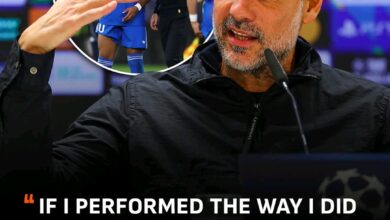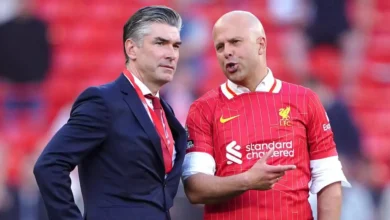54 players arriving and 14 leaving Arsenal; the transfer window is broken

The 2025 summer transfer window represents a watershed moment in modern football journalism and fan engagement. What was once a period of fevered speculation, ambitious club statements, and genuine excitement has transformed into a hollow echo chamber of recycled rumors and desperate clickbait. Arsenal Football Club, traditionally at the center of transfer speculation, finds itself linked with an astounding 54 potential signings while simultaneously facing reports of 14 departures—a mathematical impossibility that exposes the fundamental breakdown of credible transfer reporting.
This phenomenon extends far beyond simple media sensationalism. It represents a systemic failure in how football transfer news is generated, consumed, and monetized in the digital age. The annual ritual of linking Arsenal with over 100 players during previous summers has given way to a more sophisticated but equally hollow approach: the creation of elaborate transfer sagas that bear little resemblance to reality.
The current transfer window’s malaise stems from multiple interconnected factors that have converged to create a perfect storm of misinformation and fan frustration. Traditional football journalism, once reliant on genuine insider contacts and careful verification, has been replaced by a rapid-fire content generation model that prioritizes engagement over accuracy.
The financial pressures facing digital media outlets have created an environment where transfer speculation becomes a survival mechanism rather than a journalistic endeavor. Websites and publications dependent on advertising revenue must maintain constant content flow, leading to the endless recycling of stories with minimal additional verification or insight.
This ecosystem has created what can only be described as transfer window theater—a performance designed to maintain audience engagement during what are, in reality, relatively quiet periods for actual player movement. The 54 players allegedly on Arsenal’s radar represent not genuine interest but rather the industrial-scale production of content designed to fill the void between actual transfer activity.
Arsenal’s position as the perennial subject of transfer speculation is not accidental. The club’s global fanbase, combined with their historically complex relationship with the transfer market, makes them an ideal vehicle for speculative journalism. The Gunners’ supporters, conditioned by years of near-misses and “almosts,” provide a ready audience for transfer rumors, regardless of their credibility.
The list of 54 potential Arsenal signings reads like a who’s who of European football, spanning from established stars like Rodrygo and Viktor Gyökeres to relative unknowns like Konstantinos Karetsas and Sverre Halseth Nypan. This scattergun approach to transfer speculation reveals the desperation of content creators to maintain relevance in an increasingly crowded media landscape.
Among the more egregious examples of transfer window fiction are the repeated claims about Kepa Arrizabalaga’s imminent arrival, described variously as a “done deal,” “about to sign,” and “already training with Arsenal.” The progression from speculation to certainty, despite the absence of official confirmation, demonstrates how transfer rumors develop their own momentum independent of reality
The backdrop to this transfer window chaos is the continuing saga of Financial Fair Play (FFP) regulations and their enforcement. Chelsea’s recent £26.8 million fine from UEFA, accompanied by a suspended £78 million penalty, represents the kind of sanctions that were supposed to restore sanity to the transfer market. However, the reality is that such fines are mere inconveniences for clubs operating at the highest level of football finance.
The suspended nature of the additional penalty reveals the toothless nature of current FFP enforcement. For clubs like Chelsea, which have spent over £1 billion on transfers in recent years, a £26.8 million fine represents less than the cost of a single premium player. This mathematical reality exposes the fundamental flaw in the current regulatory framework: penalties that are proportionally meaningless to the wealthiest clubs.
Manchester City’s situation provides an even more stark example of regulatory capture. Despite facing over 120 charges related to FFP violations, the club continues to operate with apparent impunity. The ongoing legal process has become a case study in how wealthy institutions can use procedural complexity to avoid meaningful consequences.
The role of football media in perpetuating transfer window dysfunction cannot be understated. Major outlets, once bastions of careful reporting, have become complicit in the creation of transfer mythology. The pressure to generate content during slow news periods has led to the acceptance of increasingly tenuous sourcing standards.
The phenomenon of “transfer aggregators” has created a feedback loop where stories gain credibility through repetition rather than verification. A rumor originating from a single, poorly sourced report can quickly become “widely reported” as multiple outlets pick up the story. This creates an illusion of multiple independent sources when, in reality, the information stems from a single, potentially unreliable origin point.
The use of qualifying language has become an art form in modern transfer reporting. Phrases like “Arsenal interested,” “talks ongoing,” and “monitoring the situation” allow journalists to make claims while maintaining plausible deniability. This linguistic gymnastics enables the creation of transfer stories that are technically accurate while being practically meaningless.
Understanding why fans continue to engage with obviously fabricated transfer content requires examining the psychological mechanisms that drive football fandom. Transfer windows tap into fundamental human desires for hope, improvement, and the possibility of transformation. For supporters of clubs like Arsenal, which have experienced periods of relative underachievement, transfer speculation offers the promise of redemption.
The seasonal nature of transfer windows creates a cyclical pattern of hope and disappointment that mirrors other forms of entertainment addiction. The constant drip-feed of potential signings maintains engagement levels while rarely delivering the promised satisfaction. This creates a dependency cycle where fans seek increasingly elaborate transfer rumors to maintain their interest.
The democratization of information through social media has also transformed fan expectations. Supporters now expect continuous updates and insider information, creating pressure on media outlets to provide content even when genuine developments are absent. This demand for constant stimulation has contributed to the degradation of transfer reporting standards.
The disconnect between transfer speculation and reality is further highlighted by the economic constraints facing most football clubs. While media reports suggest Arsenal is considering signings worth hundreds of millions of pounds, the financial reality is far more constrained. The combined cost of acquiring the 54 rumored targets would exceed £2 billion, a figure that bears no relationship to any club’s actual spending capacity.
This economic impossibility is rarely acknowledged in transfer reporting, creating a fantasy environment where financial constraints are ignored in favor of narrative construction. The result is a transfer window that exists primarily in the realm of imagination rather than practical possibility.
The inflation of transfer fees in recent years has created additional pressure on clubs to demonstrate ambition through high-profile signings. This pressure has contributed to the proliferation of transfer rumors, as clubs and their media partners seek to maintain the appearance of activity even when actual business is limited.
The focus on transfer speculation has had profound implications for how clubs approach player development and strategic planning. The constant pressure to make signings can undermine long-term development strategies and create unrealistic expectations among supporters.
Young players within club systems find themselves overshadowed by speculation about potential signings, creating additional pressure on coaching staff to balance immediate results with long-term development. The case of players like Max Dowman, reportedly targeted by Manchester City and Barcelona, illustrates how transfer speculation can disrupt academy development programs.
The emphasis on new signings also devalues the contributions of existing squad members. Players who have performed well for their clubs can find their efforts overshadowed by speculation about their potential replacements, creating a destabilizing environment that can impact team performance.
Modern technology has become both a creator and amplifier of transfer window problems. Social media platforms reward sensational content with increased engagement, creating financial incentives for increasingly outlandish transfer claims. The speed of information distribution means that false stories can achieve global reach before fact-checking is possible.
Artificial intelligence and automated content generation have further complicated the transfer reporting landscape. Algorithms can now generate transfer stories based on statistical analysis and player performance data, creating seemingly sophisticated content that lacks human insight or verification.
The proliferation of football-focused websites and social media accounts has created a content ecosystem where quantity often supersedes quality. The pressure to publish first has replaced the traditional journalistic values of accuracy and verification.
Attempts to regulate transfer activity through Financial Fair Play and other mechanisms have proven inadequate to address the fundamental problems plaguing the transfer system. The focus on spending caps and financial ratios ignores the broader ecosystem of speculation and misinformation that surrounds actual transfer activity.
The lack of meaningful penalties for clubs that violate existing regulations has created a moral hazard where the potential benefits of rule-breaking significantly outweigh the risks. This has contributed to an environment where transfer activity is driven by competitive advantage rather than sustainable business practices.
International coordination between regulatory bodies remains weak, allowing clubs to exploit jurisdictional differences and regulatory gaps. The result is a patchwork of enforcement that fails to address the global nature of modern football commerce
The current trajectory of transfer window dysfunction suggests that significant reform is necessary to restore credibility to the system. Potential solutions include stricter media regulation, enhanced financial penalties, and fundamental changes to how transfer information is disseminated and consumed.
The introduction of verified transfer databases and official communication channels could reduce the proliferation of false information. However, such changes would require cooperation between clubs, media outlets, and regulatory bodies—a level of coordination that has proven difficult to achieve.
Alternative approaches might include the elimination of transfer windows entirely, allowing player movement throughout the year while reducing the artificial pressure that creates transfer speculation seasons. This would distribute transfer activity more evenly and reduce the media frenzy that currently characterizes summer and winter windows.
The broader implications of transfer window dysfunction extend beyond football into questions about media literacy, consumer protection, and the commodification of hope. Young fans, in particular, are vulnerable to the emotional manipulation inherent in transfer speculation, creating unrealistic expectations about their clubs’ capabilities and ambitions.
The time and emotional energy invested by supporters in following transfer rumors represents a significant social cost that is rarely acknowledged. The opportunity cost of engaging with false information includes reduced engagement with actual football analysis, player development, and tactical understanding.
The international reach of modern football means that transfer window dysfunction affects global audiences, contributing to the spread of misinformation and the degradation of journalistic standards in multiple markets simultaneously.
The 2025 transfer window represents a nadir in football journalism and fan engagement. The spectacle of Arsenal being linked with 54 different players while facing reports of 14 departures illustrates the complete breakdown of credible transfer reporting. This system serves no one well: clubs are misrepresented, players are exploited, and fans are deliberately misled.
The solution requires fundamental changes to how transfer information is generated, distributed, and consumed. This includes stricter journalistic standards, enhanced regulatory oversight, and a cultural shift away from the commodification of hope that currently characterizes transfer window coverage.
Without such changes, transfer windows will continue to function as elaborate theatrical performances that bear little resemblance to the business of football. The cost of this dysfunction extends far beyond individual clubs or media outlets—it represents a systematic failure of the institutions that should serve football’s global community.
The future of football depends on restoring credibility to transfer reporting and creating sustainable systems for player movement that serve the interests of all stakeholders. Until these changes occur, fans will continue to be subjected to the hollow spectacle of transfer windows that promise everything while delivering nothing of substance.
The broken transfer window is not just a football problem—it’s a symptom of broader issues in modern media, regulation, and the relationship between commercial interests and public information. Addressing these challenges requires recognition that the current system is fundamentally broken and commitment to building something better in its place.















